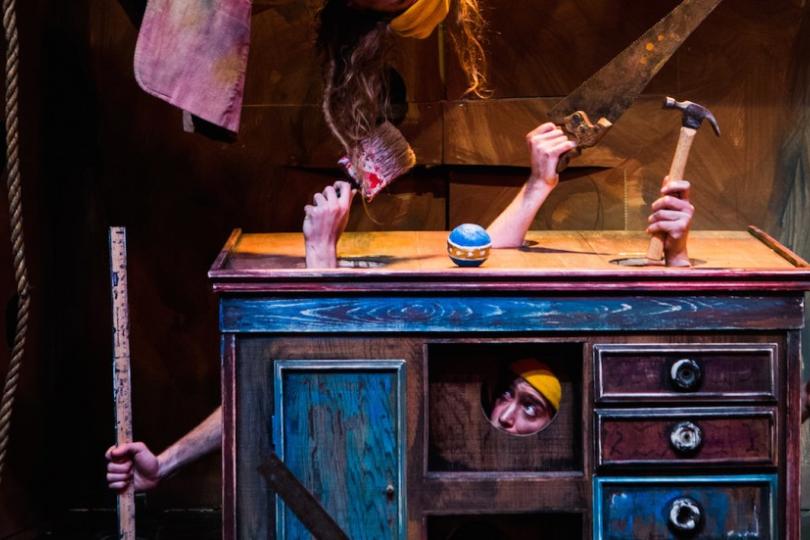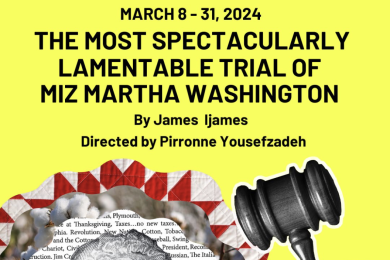A malnourished, indigent man trapped in a room with no exit, trying to navigate a Mobius maze of mysterious portals while matching wits with his own doppelganger and a phalanx of grasping, disembodied arms. It sounds a lot more like the stuff of nightmares and David Lynch films than a stage production for kids six and up, but that’s the particular genius of Open Eye Figure Theater. Horror and whimsy often straddle a fine line and Open Eye tows it better than most.
Creepiness aside, it’s a bit of a gamble to pitch a nearly dialogue-free production at least partially at grade-schoolers. Granted, there’s a long history of wordless kids’ entertainment - as a child owner myself, I can attest that semi-silent comedy like Shaun the Sheep and old Roadrunner and Coyote cartoons can delight even my hyperverbal five-year-old--but attempting it live on stage takes a certain confidence in your performers’ ability and your audience’s patience.
With Joel Sass’s Nothing is Something, that confidence is justified. What the show lacks in dialogue and narrative, it makes up for in physicality and visual inventiveness, both of which are evident from the very beginning. The play opens with Noah Sommers Haas’s presumably homeless protagonist entering not from stage left or right, but from stage top, clambering down a dangling rope and dropping into a small room. The space is empty but for a wooden desk and a smattering of small objects like an alarm clock, a pair of scissors and a tiny chair. And, of course, a preponderance of holes.
Unpredictable possibility
As the title suggests, those holes are the key to Nothing is Something. As Haas acquaints himself with his new environs, the holes scattered across the walls, desk and floor provide unexpected avenues for exploration. Some lead off to nowhere, others bend the laws of physics and still others contain hidden treasures. No two holes seem to share the same properties and all of them appear to change their functions at random. It’s a rather ingenious way to transform a small space--both in the context of the play and the physical layout of the Open Eye stage--into a nearly infinite realm of unpredictable possibility.
Haas’s claustrophobic expedition bears all sorts of unexpected fruit, including a pair of unsettling marionettes, a host of flailing arms emerging from the holes at inopportune moments, and of course the aforementioned doppelganger (Liz Schachterle) who pops out of the desk and immediately establishes a partnership/rivalry with her lookalike. There’s no story arc to speak of, just a series of bizarre mini-adventures in whimsy and metaphysics. It’s sort of a like watching a pair of Harpo Marxes set loose in an M.C. Escher print.
But there’s plenty going on underneath that simple surface. Going back to the physical schema of Nothing is Something, Sass and playwright Josef Evans have crafted a fascinating commentary on the limitations of a stage production, or rather the lack thereof. A traditional play’s physical world is limited to what the audience can see onstage. Conveying the universe beyond that usually falls to dialogue and exposition. It’s one of those built-in obstructions that it’s such fun to watch theater artists navigate. That makes it all the more interesting to see Sass and Evans construct an unseen yet very palpable world outside of the audience’s view.
Theatrics beyond the stage
Nothing is Something is as much concerned with the ethereal goings on behind the walls, inside the drawers and beneath the floorboards as it is with the antics of its twin protagonists. Introducing that acute awareness of a broader universe is equal parts liberating and claustrophobic. Yes, there’s a realm of apparently infinite possibility beyond the room, but our heroes are still trapped within it, being acted upon by forces neither they nor we have the tools to comprehend.
Sorry, that may be getting a bit too heavy for a show that is, after all, primarily a comedy, and quite a funny one at that. Haas and Schachterle’s expressive faces and aptitude for physical humor, combined with their characters’ apparent indigence, bring to mind vintage Charlie Chaplin routines. It’s their good-natured innocence and indefatigable curiosity that keep the inherent horror of their surroundings from becoming overwhelming. They’re written and acted as apprehensive explorers rather than desperate prisoners, and that allows us to laugh at their myriad plights instead of trembling.
Speaking of trembling, as we waited for Nothing Is Something to begin, my five-year-old buried his face in my wife’s shoulder, freaked out by Eric Jensen’s eerie score and those ominous-looking holes on the stage. I worried that we’d have to split early, but once the show started he slowly dropped his reservations and got into the action, howling with laughter at Haas’s pratfalls and squealing with anticipation as Schachterle reached into yet another chasm. That seems to me an appropriate impact for a show about embracing the unknowable and exploring worlds both internal and external.
He did acknowledge afterward that he was still scared of all of those clutching arms sprouting out of nowhere, but that’s OK too. When you dare to delve into the abyss, you’re bound to pick up a little nightmare fuel along the way.
Ira Brooker
Ira Brooker is a writer and editor residing in Saint Paul's scenic Midway neighborhood. He holds down a corporate job by day and does freelance and creative work at night. He is a former editor of
Minnesota Playlist and has been published in a number of venues both local and national, several of which you may have even heard of. He occasionally prattles on about pop culture at
A Talent For Idleness and maintains an archive at
irabrooker.com.





